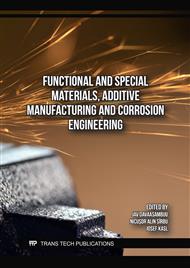[1]
Chin, S. Y., Dikshit, V., Meera Priyadarshini, B., & Zhang, Y. (2020). Powder-Based 3D Printing for the Fabrication of Device with Micro and Mesoscale Features. Micromachines, 11(7), 658.
DOI: 10.3390/mi11070658
Google Scholar
[2]
Guan, X., & Zhao, Y. F. (2020). Modeling of the laser powder–based directed energy deposition process for additive manufacturing: a review. The International Journal of Advanced Manufacturing Technology.
DOI: 10.1007/s00170-020-05027-0
Google Scholar
[3]
Frazier, W. E. (2014). Metal additive manufacturing: A review. Journal of Materials Engineering and Performance, 23(6), 1917-1928.
DOI: 10.1007/s11665-014-0958-z
Google Scholar
[4]
Lorenz, K. A., Jones, J. B., Wimpenny, D. I., & Jackson, M. R. (2015). A review of hybrid manufacturing. In Proceeding of solid freeform fabrication (p.96–108). http://utw10945.utweb.utexa s.edu/sites/default/fles/2015/2015-8-Lorenz.pdf.
Google Scholar
[5]
Gibson, I., Rosen, D., & Strucker, B. (2015). Directed energy deposition process,. Additive manufacturing technology (p.245
Google Scholar
[7]
Banait, S. M., Paul, C. P., Jinoop, A. N., Kumar, H., Pawade, R. S., & Bindra, K. S. (2020). Experimental investigation on laser directed energy deposition of functionally graded layers of Ni–Cr–B–Si and SS316L. Optics & Laser Technology, 121, 105787.
DOI: 10.1016/j.optlastec.2019.105787
Google Scholar
[8]
Vilaro, T., Colin, C., & Bartout, J.-D. (2011). As-fabricated and heat-treated microstructures of the Ti-6Al-4V alloy processed by selective laser melting. Metallurgical and Materials Transactions A, 42(10), 3190-3199.
DOI: 10.1007/s11661-011-0731-y
Google Scholar
[9]
Karunakaran, K. P., Suryakumar, S., Pushpa, V., & Akula, S. (2010). Low-cost integration of additive and subtractive processes for hybrid layered manufacturing. Robotics and Computer-Integrated Manufacturing, 26(5), 490-499.
DOI: 10.1016/j.rcim.2010.03.008
Google Scholar
[10]
Buchanan, C., & Gardner, L. (2019). Metal 3D printing in construction: A review of methods, research, applications, opportunities, and challenges. Engineering Structures, 180, 332-348.
DOI: 10.1016/j.engstruct.2018.11.045
Google Scholar
[11]
Chamanfar, A., Jahazi, M., & Cormier, J. (2016). On the hot deformation behavior of Inconel 718 superalloy produced by additive manufacturing. Materials Science and Engineering: A, 669, 229-240.
DOI: 10.1016/j.msea.2016.05.098
Google Scholar
[12]
Reed, R. C. (2006). The Superalloys: Fundamentals and Applications. Cambridge University Press.
DOI: 10.1017/CBO9780511541285
Google Scholar
[13]
Laveskog, H., & Seifeddine, S. (2018). Influence of laser power and scanning speed on surface quality and dimensional accuracy of Inconel 718 produced by selective laser melting. Journal of Manufacturing Processes, 35, 526-536.
DOI: 10.1016/j.jmapro.2018.08.020
Google Scholar
[14]
King, W. E., Barth, H. D., Castillo, V. M., Gallegos, G. F., Gibbs, J. W., Hahn, D. E., Kamath, C., & Rubenchik, A. M. (2014). Observation of keyhole-mode laser melting in laser powder-bed fusion additive manufacturing. Journal of Materials Processing Technology, 214(12), 2915-2925.
DOI: 10.1016/j.jmatprotec.2014.06.005
Google Scholar
[15]
DebRoy, T., Wei, H. L., Zuback, J. S., Mukherjee, T., Elmer, J. W., Milewski, J. O., & Zhang, W. (2018). Additive manufacturing of metallic components – Process, structure, and properties. Progress in Materials Science, 92, 112-224.
DOI: 10.1016/j.pmatsci.2017.10.001
Google Scholar
[16]
Thompson, S. M., Bian, L., Shamsaei, N., & Yadollahi, A. (2015). An overview of Direct Laser Deposition for additive manufacturing; Part I: Transport phenomena, modeling, and diagnostics. Additive Manufacturing, 8, 36-62.
DOI: 10.1016/j.addma.2015.07.001
Google Scholar
[17]
Calignano, F. (2014). Design optimization of supports for overhanging structures in aluminum and titanium alloys by selective laser melting. Materials & Design, 64, 203-213.
DOI: 10.1016/j.matdes.2014.07.043
Google Scholar
[18]
Zhang, Y., & Liou, F. (2004). Adaptive slicing for a laser-aided metal deposition process. Journal of Mechanical Design, 126(2), 254-261.
DOI: 10.1115/1.1688775
Google Scholar
[19]
Paul, R., & Anand, S. (2015). Process energy analysis and optimization in selective laser sintering. Journal of Manufacturing Systems, 36, 231-238.
DOI: 10.1016/j.jmsy.2014.06.012
Google Scholar
[20]
Baufeld, B., Biest, O. V., & Gault, R. (2011). Additive manufacturing of Ti–6Al–4V components by shaped metal deposition: Microstructure and mechanical properties. Materials & Design, 31(S2), S106-S111.
DOI: 10.1016/j.matdes.2009.11.032
Google Scholar
[21]
Rombouts, M., Kruth, J. P., Froyen, L., & Mercelis, P. (2006). Fundamentals of selective laser melting of alloyed steel powders. CIRP Annals, 55(1), 187-192.
DOI: 10.1016/s0007-8506(07)60395-3
Google Scholar
[22]
Yadroitsev, I., Thivillon, L., Bertrand, P., & Smurov, I. (2007). Strategy of manufacturing components with designed internal structure by selective laser melting of metallic powder. Applied Surface Science, 254(4), 980-983.
DOI: 10.1016/j.apsusc.2007.08.074
Google Scholar
[23]
Zhu, Y., & Choi, S. H. (2016). Granulation technologies for powder-based AM: A critical review. Powder Technology, 297, 259-271.
DOI: 10.1016/j.powtec.2016.04.050
Google Scholar
[24]
Hausild, P., Karlík, M., & Klesnil, M. (2006). Influence of powder granulation on the mechanical properties of components produced by SLM. Journal of Alloys and Compounds, 428(1-2), 61-68.
DOI: 10.1016/j.jallcom.2006.04.001
Google Scholar
[25]
Mohammed, A., & Abdullah, A. (2018, November). Scanning electron microscopy (SEM): A review. In Proceedings of the 2018 International Conference on Hydraulics and Pneumatics-HERVEX, Băile Govora, Romania (Vol. 2018, pp.7-9).
Google Scholar


